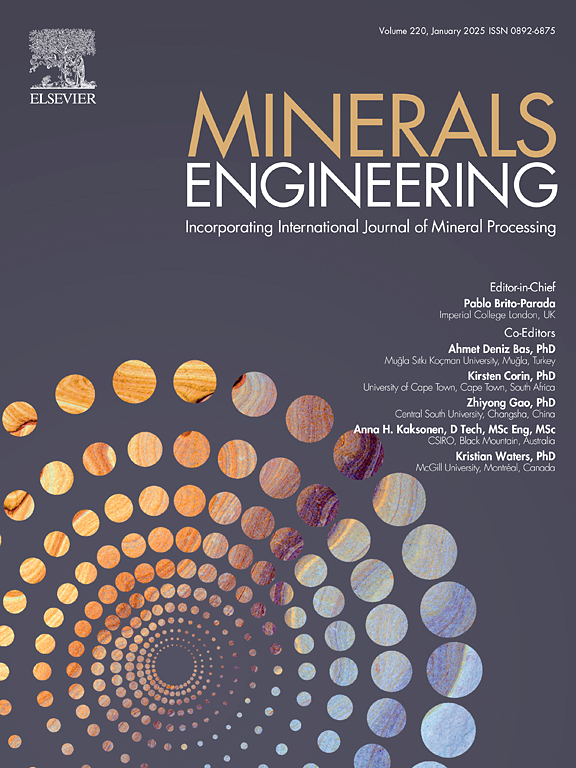热改性黄铁矿高效回收金及其机理
IF 5
2区 工程技术
Q1 ENGINEERING, CHEMICAL
引用次数: 0
摘要
从废水中回收黄金应具有成本效益、高效率和环保性。本研究通过对黄铁矿进行热改性制备了含铁(II,III)体系的吸附剂。研究了热改性温度、黄铁矿来源、pH 值、离子强度、吸附剂固液比和共存金属离子对吸附的影响。此外,还探讨了铁离子的可去除性,并进行了多次吸附-解吸实验,以验证吸附剂的稳定性和可回收性。利用吸附等温线、热力学、动力学和光谱学分析了吸附规律和机理。结果表明,在 300°C 下改性的天然黄铁矿(N-Py-300)是一种更合适的金吸附剂,在 25°C 时的最大吸附量为 1055.2 mg/g。当与其他金属离子共存时,N-Py-300 对金(III)的吸附具有高度选择性。使用 10 % 硫脲和 2 % HCl 的混合物作为解吸剂,可促进 N-Py-300 中几乎所有金的解吸,从而回收金并重复使用 N-Py-300。加入 Ca(OH)2 可以有效减少从吸附剂中释放的铁离子。吸附动力学和等温线数据与伪二次模型和 Langmuir 模型十分吻合,表明 Au(III) 以单层形式化学吸附在 N-Py-300 上,并被还原成 Au(0) 和 Au(Ⅰ)。pH 值和 IS 也会影响吸附行为,这意味着存在静电效应。我们的研究结果表明,热修饰黄铁矿可用于从废水中有效回收贵金属,并为黄铁矿的资源化利用提供了实验基础。本文章由计算机程序翻译,如有差异,请以英文原文为准。
Highly efficient recovery of gold by thermally modified pyrite and its mechanism
Gold recovery from wastewater should be cost-effective, efficient, and environmentally friendly. In this study, adsorbents containing Fe(II,III) systems were prepared via thermal modification of pyrite. The effects of thermal modification temperature, the source of pyrite, pH, ionic strength, adsorbent solid–liquid ratio, and coexisting metal ions on adsorption were investigated. Further, the removability of iron ions was explored, and multiple adsorption–desorption experiments were conducted to verify the stability and recyclability of the adsorbent. The adsorption law and mechanisms were analyzed using adsorption isotherms, thermodynamics, kinetics, and spectroscopy. The results revealed that the natural pyrite modified at 300°C ( N-Py-300) was a more suitable gold adsorbent with a maximum adsorption of 1055.2 mg/g at 25 °C. When coexisting with other metal ions, N-Py-300 exhibited highly selective adsorption of Au(III). Using a mixture of 10 % thiourea and 2 % HCl as a desorbent facilitated the desorption of almost all Au from N-Py-300, resulting in the recovery of Au and the reuse of N-Py-300. The Fe ions released from the adsorbent were effectively reduced by the addition of Ca(OH)2. The adsorption kinetics and isotherm data were in strong agreement with the pseudo-secondary and Langmuir models, indicating that Au(III) was chemisorbed on N-Py-300 as a monolayer and that Au(III) was reduced to Au(0) and Au(Ⅰ). The pH and IS also affected the adsorption behavior, implying that an electrostatic effect exists. Our findings provide that the thermally modified pyrite can be used to recover precious metals from wastewater efficiently, and provides an experimental basis for the resourceful use of pyrite.
求助全文
通过发布文献求助,成功后即可免费获取论文全文。
去求助
来源期刊

Minerals Engineering
工程技术-工程:化工
CiteScore
8.70
自引率
18.80%
发文量
519
审稿时长
81 days
期刊介绍:
The purpose of the journal is to provide for the rapid publication of topical papers featuring the latest developments in the allied fields of mineral processing and extractive metallurgy. Its wide ranging coverage of research and practical (operating) topics includes physical separation methods, such as comminution, flotation concentration and dewatering, chemical methods such as bio-, hydro-, and electro-metallurgy, analytical techniques, process control, simulation and instrumentation, and mineralogical aspects of processing. Environmental issues, particularly those pertaining to sustainable development, will also be strongly covered.
 求助内容:
求助内容: 应助结果提醒方式:
应助结果提醒方式:


